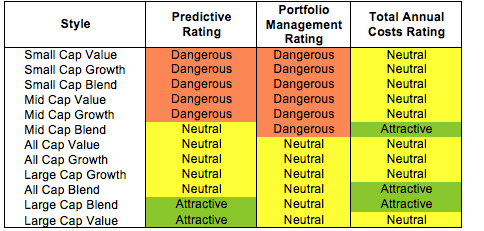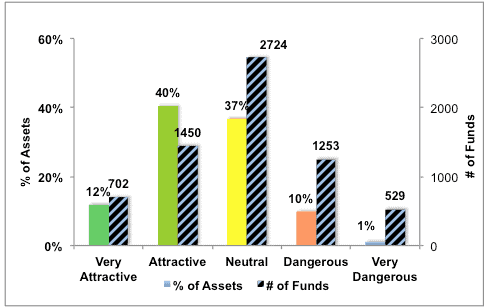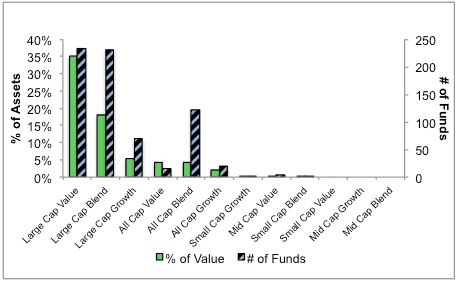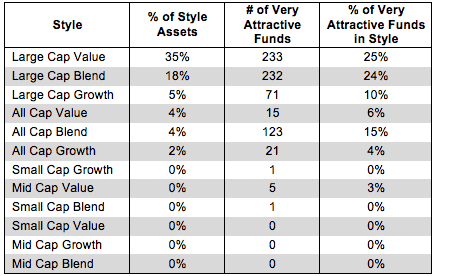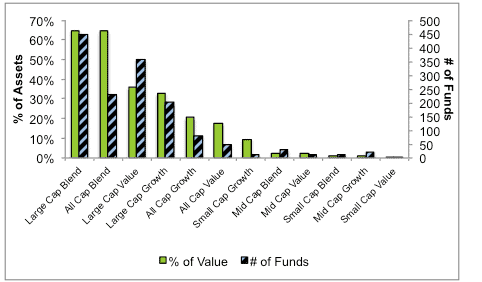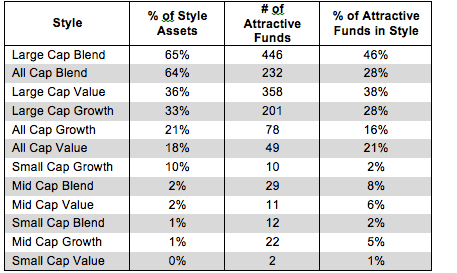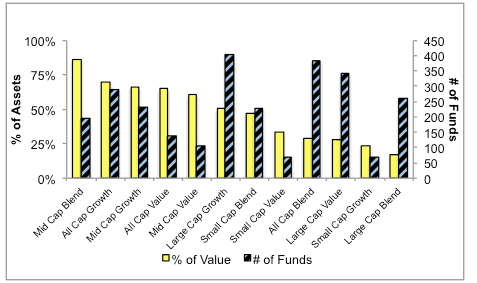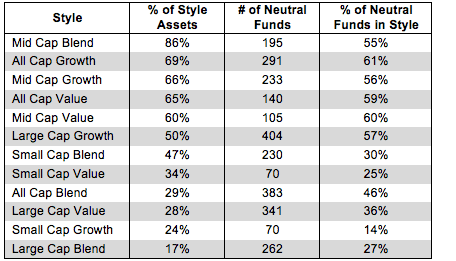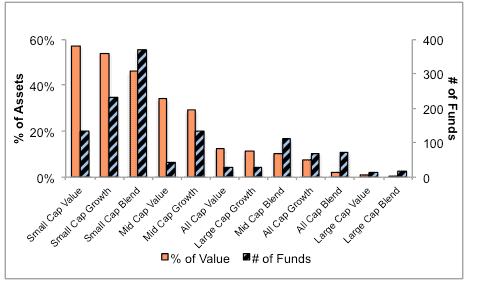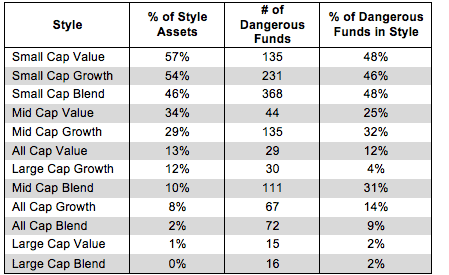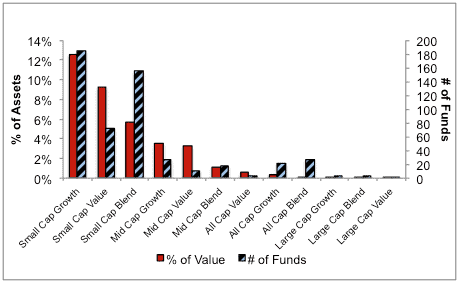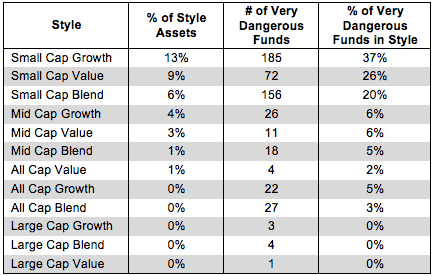At the beginning of the fourth quarter of 2014, only the Large Cap Value and Large Cap Blend styles earn an Attractive rating. My style rankings are based on the aggregation of my fund ratings for every ETF and mutual fund in each style.
Investors looking for style funds that hold quality stocks should look no further than the Large Cap Blend and Large Cap Value styles. These styles house the most Attractive-or-better rated funds. Figures 6 and 7 provide details. The primary driver behind an Attractive fund rating is good portfolio management, or good stock picking, with low Total Annual Costs.
Note that the Attractive-or-better Predictive ratings do not always correlate with Attractive-or-better Total Annual Costs. This fact underscores that (1) cheap funds can dupe investors and (2) investors should invest only in funds with good stocks and low fees.
See Figures 4 through 13 for a detailed breakdown of ratings distributions by investment style. See my ETF & mutual fund screener for rankings, ratings and reports on 6800+ mutual funds and 400+ ETFs.
My fund rating methodology is detailed here.
All of my reports on the best & worst ETFs and mutual funds in every sector and investment style are available here.
Figure 1: Ratings For All Investment Styles
Source: New Constructs, LLC and company filings
To earn an Attractive-or-better Predictive Rating, an ETF or mutual fund must have high-quality holdings and low costs. Only 2152 style ETFs and mutual funds meet these requirements, which is only 32% of all style ETFs and mutual funds.
Fidelity Value Discovery Fund (FVDKX) is my top Large Cap Value mutual fund. It gets my Very Attractive rating by allocating over 42% of its value to Attractive-or-better-rated stocks.
Johnson & Johnson (JNJ) is one of my favorite stocks held by FVDKX and earns my Very Attractive rating. As I’ve stated before, Johnson & Johnson is a great pick in the current market. Over the last decade, Johnson & Johnson has grown after-tax profits (NOPAT) by 8% compounded annually. In 2013, the company earned a return on invested capital (ROIC) of 15%, which puts it in the top quintile of all the companies I cover. Johnson & Johnson has also generated positive economic earnings every year for the past 16 years. At its current price of ~$97/share, JNJ has a price to economic book value (PEBV) of just 1.1. This ratio implies that the market expects Johnson & Johnson to grow NOPAT by only 10% for the remaining life of the company. With Johnson & Johnson’s history of consistent profit growth and an aging U.S. population, the company should easily surpass such low market expectations.
Small-Cap ProFund (SLPSX) is my worst Small Cap Blend mutual fund. It gets my Very Dangerous rating by allocating over 52% of its value to Neutral-or-worse-rated stocks, and to make matters worse, charges investors Total Annual Costs of 5.50%.
SunEdison (SUNE) is one of my least favorite stocks held by SLPSX and earns my Dangerous rating. SUNE’s after-tax operating (NOPAT) losses have deepened in recent years, from -$50 million in 2009 to -$220 million in 2013. The company currently earns an ROIC of -5%, which puts it in the bottom quintile of all companies I cover. SunEdison’s valuation looks rather high given its increasingly negative NOPAT. To justify its current price of ~$15/share, SUNE must achieve pre-tax margins of 15% and grow revenue by 12% compounded annually for the next 13 years. Such high margins and revenue growth seem unlikely, especially for a company that has become consistently and increasingly unprofitable. Declining NOPAT and elevated market expectations make SUNE a stock to avoid.
Figure 2 shows the distribution of our Predictive Ratings for all investment style ETFs and mutual funds.
Figure 2: Distribution of ETFs & Mutual Funds (Assets and Count) by Predictive Rating
Source: New Constructs, LLC and company filings
Figure 3 offers additional details on the quality of the investment style funds. Note that the average Total Annual Cost of Very Dangerous funds is over five times that of Very Attractive funds.
Figure 3: Predictive Rating Distribution Stats
* Avg TAC = Weighted Average Total Annual Costs
Source: New Constructs, LLC and company filings
This table shows that only the best of the best funds get our Very Attractive Rating: they must hold good stocks AND have low costs. Investors deserve to have the best of both and we are here to give it to them.
Ratings by Investment Style
Figure 4 presents a mapping of Very Attractive funds by investment style. The chart shows the number of Very Attractive funds in each investment style and the percentage of assets in each style allocated to funds that are rated Very Attractive.
Only 702 investment style funds earn our Very Attractive rating.
Figure 4: Very Attractive ETFs & Mutual Funds by Investment Style
Source: New Constructs, LLC and company filings
Figure 5 presents the data charted in Figure 4
Figure 5: Very Attractive ETFs & Mutual Funds by Investment Style
Source: New Constructs, LLC and company filings
Figure 6 presents a mapping of Attractive funds by investment style. The chart shows the number of Attractive funds in each style and the percentage of assets allocated toAttractive-rated funds in each style.
Note that the Large Cap Blend and Large Cap Value styles have the most Attractive-rated funds.
Figure 6: Attractive ETFs & Mutual Funds by Investment Style
Source: New Constructs, LLC and company filings
Figure 7 presents the data charted in Figure 6.
Figure 7: Attractive ETFs & Mutual Funds by Investment Style
Source: New Constructs, LLC and company filings
Figure 8 presents a mapping of Neutral funds by investment style. The chart shows the number of Neutral funds in each investment style and the percentage of assets allocated to Neutral-rated funds in each style.
Figure 8: Neutral ETFs & Mutual Funds by Investment Style
Source: New Constructs, LLC and company filings
Figure 9 presents the data charted in Figure 8.
Figure 9: Neutral ETFs & Mutual Funds by Investment Style
Source: New Constructs, LLC and company filings
Figure 10 presents a mapping of Dangerous funds by fund style. The chart shows the number of Dangerous funds in each investment style and the percentage of assets allocated to Dangerous-rated funds in each style.
Figure 10: Dangerous ETFs & Mutual Funds by Investment Style
Source: New Constructs, LLC and company filings
Figure 11 presents the data charted in Figure 10. Note that Dangerous-rated Small Cap Value, Small Cap Growth, and Small Cap Blend funds make up nearly half of the total funds in those styles.
Figure 11: Dangerous ETFs & Mutual Funds by Investment Style
Source: New Constructs, LLC and company filings
Figure 12 presents a mapping of Very Dangerous funds by fund style. The chart shows the number of Very Dangerous funds in each investment style and the percentage of assets in each style allocated to funds that are rated Very Dangerous.
Figure 12: Very Dangerous ETFs & Mutual Funds by Investment Style
Source: New Constructs, LLC and company filings
Figure 13 presents the data charted in Figure 12.
Figure 13: Very Dangerous ETFs & Mutual Funds by Investment Style
Source: New Constructs, LLC and company filings
Kyle Guske II contributed to this report.
Disclosure: David Trainer owns JNJ. David Trainer and Kyle Guske II receive no compensation to write about any specific stock, sector or theme.

